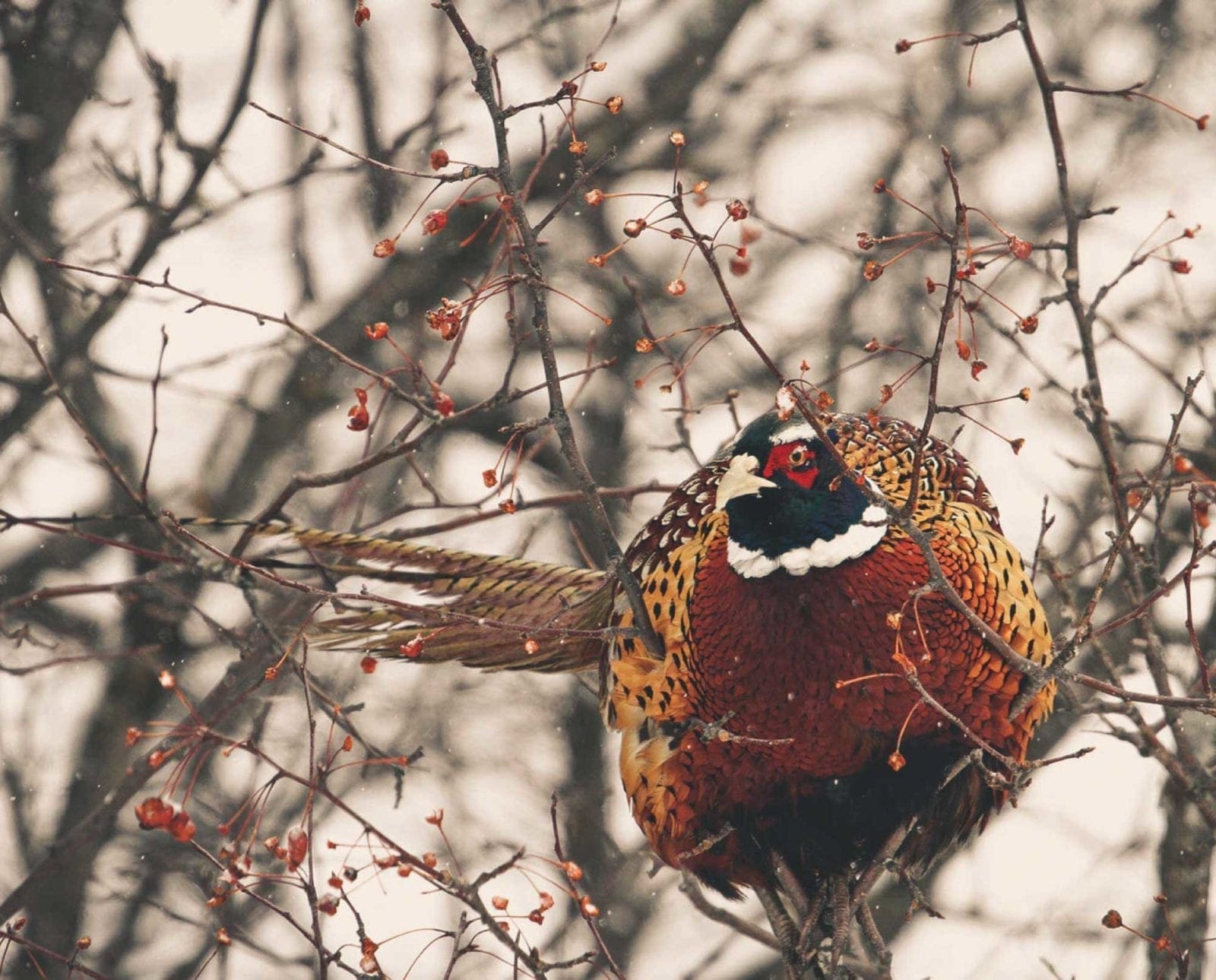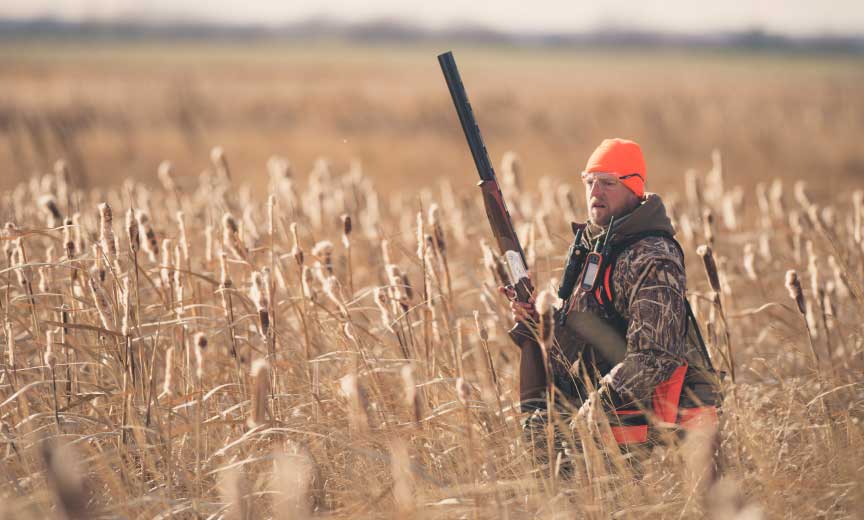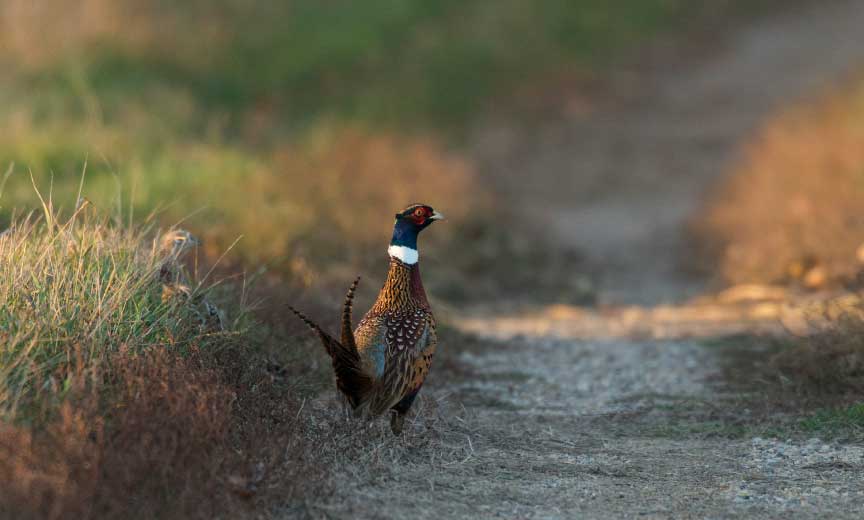Home » Pheasant Hunting » How Tough is a Rooster Pheasant?
How Tough is a Rooster Pheasant?

Edgar Castillo is a recently retired law enforcement officer for…
The pheasant has earned a reputation as a physically tough bird in the upland community and here is why.
The male ring-neck pheasant rooster is both the admiration and abomination of upland hunters and bird dogs everywhere, who chase the wily bird from October to late January. Let’s get something out of the way right now . . . today’s pheasants aren’t our fathers’ and grandfathers’ pheasants from back in the “good ol’ days.” The pheasants we are dealing with today are the Y2K generation enhanced version—smarter, warier, faster, and some would say even more diabolical in their ways of evading hunters and dogs. One could even say they are the arch-nemesis or super villains of the upland bird community.
Identifying the Rooster Pheasant
The male ring-neck rooster’s most noticeable physical features are its long check-mark style tail feathers when it’s standing at attention in a field and of course the white ring around their neck. These are the features hunters look for while the cockbird is in flight for proper target acquisition.
The male ring-neck pheasant is a gaudy immigrant. He rivals the male wood duck as our most metallic, multicolored feathered citizen. The Chinese transplant’s feathered body consists of 17 different colors. Plumage includes hues of gold, brown, green, purple, and white to name a few. When the sunlight hits it, it appears almost chromatic and iridescent. Its coloration is nothing short of spectacular when held in the hands of a bird hunter. A rooster’s head is black, blue and green with the distinctive red wattle and signature white ring-neck. Throw in the ivory colored beak to give it a little bit of detail.
Weight and Length on those Roosters
Weight: Male ring-neck pheasants (roosters) average two to three pounds, a nice feeling of heft when placed in one’s game bird vest, while hens average three pounds.
Length: Males measure 24 to 35 inches long (a rooster’s tail accounts for more than 20 inches of length). Check local areas for Pheasant Hunting Contests—Longest Tail Feathers. Hens are smaller with a much shorter tail.
The Natural Rooster Armor
Pheasants have feather-like armor! This has been a common statement and complaint among pheasant hunters who manage to hit their target and ring-necks continue to fly appearing almost unscathed. This could be attributed to pheasants possessing a built-in suit of armor making them almost bulletproof.
Pheasants provide the hunter the all too common target that is flying away, which means the string of shot pellets hitting the birds backside tends to slow down and inhibit penetration and lethality. It makes the importance of proper shot size and chokes for pheasant hunting even greater.
Running, Flying, Swimming, and Frustrating Hunters
Pheasants can run at a speed of 8 to 10 miles per hour, which is still plenty fast enough to frustrate pheasant hunters. Pheasants young and old quickly learn that to avoid becoming the main course at dinner, they need to run, not fly. And fly they can! At a speed of 35 to 48 miles per hour, roosters can reach a top speed of up to 60 mph when being chased and trying to outrun hot lead or steel!

One attribute usually not associated with pheasants is that they don’t mind the water. They are also known to be able to swim. It’s common for pheasants to gravitate towards the cattails and marshes when pressured. It makes sense that with no other place to go, roosters will go to where hunters are least likely to follow. Guess what, there’s water in those areas. How many times have ring-neck pheasants flushed from Waterfowl Production Areas as hunters are walking along the edge of a slough? An anomaly? I think not. I have for years hunted pheasants within the public confines of the Cheyenne Bottoms of central Kansas while wading in water several inches deep. This defensive strategy works well as long as hunters aren’t willing to get their boots wet.
Read: Hunting Heavy Pressured Pheasant
Superhero Senses of the Rooster Pheasant
It’s safe to say most avian creatures probably rely on their vision as their number one mode of defense. Humans see at 25 frames per second, whereas pheasants see at the rate of 50, which allows them to detect movement much faster and flee. Pheasants’ eyes or lenses are positioned far forward, a trait which increases image size. Far better to see approaching hunters clad in their blaze orange. It has been said that pheasants can spot a hawk shadow a quarter mile away! If this holds any truth, what is to say that the glint of a shotgun could also be seen from a great distance?
If pheasants’ sight isn’t already “super,” then their hearing will astonish bird hunters. Roosters are able to hear 10 times the sound range that humans do. During breeding season, the pheasant’s hearing region of their brain increases. This boost probably helps with detecting rival crowing roosters. Would it be far-fetched to speculate that during hunting season roosters redevelop this audible enhancement? The old saying about being quiet getting out of trucks holds true. Constant hunting pressure has conditioned roosters to bug out at the slightest door slamming, dog barking, or any other noise that is NOT natural. Pheasants are experts at putting “hunter” noise and danger together when something doesn’t feel or sound right.

Another way pheasants use their natural abilities against bird hunters is their extra-sensory pads on their feet. These special pads can sense vibrations. This early warning system serves as a form of detection with approaching danger . . . this translates into tan and orange wearing hunters carrying long “thunder-sticks” with their four-legged counterparts trouncing through a field.
Last but certainly not least are the rooster’s spurs. Spurs can determine the age between nubby first-of-the-year old juvenile roosters compared to ¾ of an inch (measurement includes leg bone) spurs of an “old wily” mature adult cockbird, with at least a year of experience evading hunters. Another general rule when dealing with spurs and deciding factor is if the spur is black, shiny, and sharply pointed, then the rooster is an adult.
Sharp rooster spurs can maim and even kill rival male ring-necks when fighting for the affection of those hens and keeping their harems all to themselves. Spurs can also cause injury to bird dogs.
Weird But True Game Bird Tales?
It is said that during World War I, several species of birds were “enlisted” to assist in the war effort. Everyone knows about how homing or carrier pigeons were used to carry messages during both World Wars. Thirty two pigeons were awarded the Dickens Medal, an honor instituted to recognize the work of animals in war.
https://en.wikipedia.org/wiki/War_pigeon
The Pheasant Radar System. Not to be outdone and not as well-known – but equally as useful, were pheasants. Pheasants served with particular distinction by providing an early warning system. Besides the pheasants’ sharp ears, their highly enhanced foot pads could detect the slightest vibrations through the ground, such as the footfall of distant armies or the pounding of artillery.
The Battle of Dogger Bank was a naval engagement between the British and Germans which occurred on January 24, 1915, near the Dogger Bank in the North Sea during World War I. It was reported that a flock of pheasants “shrieked themselves hoarse,” thereby raising an alarm over the battle, 216 miles away!
Edgar Castillo is a recently retired law enforcement officer for a large Kansas City metropolitan agency. He also served in the United States Marine Corps for twelve years. Edgar longs for the colors of autumn and frosty, winter days so he can explore the landscapes in search of wild birds in wild places. His passion lies in the uplands as he self-documents his travels across public lands throughout Kansas hunting open fields, walking treelines, & bustin’ through plum thickets.




curious that the article only discusses humans as the pheasants principal predator – I’d think we’re probably the least of their threats
Yes, I agree. However I wrote the article in a good fun kinda way as in that the rooster pheasant is a worthy adversary for hunters. It seems to me that we as bird hunters always appear to hear elaborate stories of escape from these tough birds. And yes, coyotes, foxes, and raptors are always looking for a nice pheasant meal.